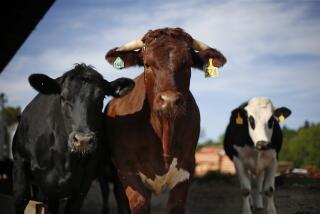Vaccinated Monkeys Found to Resist AIDS : Health: Animals injected with a weakened version of the simian virus seem to be immunized, scientists say.
Frustrated by the repeated failure of efforts to develop an AIDS vaccine, Harvard University researchers took a flyer. They turned to a method scorned by other scientists as at best old-fashioned and at worst unsafe, and they injected four rhesus monkeys with a weakened form of the virus.
Today, in what is being hailed as an exciting landmark in the quest for a vaccine to prevent AIDS, the Harvard group reports that its vaccine immunized the monkeys with the longest-lasting, strongest protection ever achieved in any such AIDS experiment.
The findings, reported in today’s issue of Science, have turned heads in the AIDS vaccine research community for two reasons. First, three years after being inoculated the monkeys have resisted very strong doses of the virus that causes AIDS in primates. This is a longer period of immunity than any previous experiment has demonstrated.
Second, the findings indicate that a classical approach to designing vaccines, using a live form of the virus, holds promise for AIDS at a time when most scientists have staked hopes on high-tech methods of genetic engineering.
“The early returns of what has been seen are very, very promising,” said Dani P. Bolognesi, an AIDS expert at Duke University. “It could very definitely lead directly to a vaccine, but just as important is that it can tell us what is necessary in order for a vaccine to work.”
The monkeys were inoculated with a so-called live attenuated vaccine that employed an altered, yet still living, form of SIV, a close cousin of the human AIDS virus. Eight months after being injected with an infectious form of the virus, and 18 weeks after being given a much stronger dose, they have shown no signs of getting sick.
Anthony Fauci, director of the National Institute of Allergy and Infectious Diseases, the branch of government responsible for AIDS research, said: “The results themselves were impressive. And even more important, this is a clear example of the feasibility of the use of live attenuated vaccines.”
Even if such a vaccine is created, testing it in humans will pose difficulties. It could immunize those not yet exposed to HIV, but uninfected people might be reluctant to volunteer for such a study. Fauci said it will be at least a year before human studies can begin.
“The whole process, even if it is successful, is going to take years,” Fauci said.
The lead scientist on the Harvard project, Ronald Desrosiers, said he was pushed toward the live attenuated method because nothing else he tried worked.
Describing himself as a voice in the wilderness, Desrosiers said: “What pushed us in this direction was one vaccine failure after another in our idealized, optimal laboratory setting. So I reversed directions and said, ‘Well, we’ve got to go right for the jugular, we’ve got to find something more potent.’ ”
He added: “Nothing else we have tried has come anywhere close to what we have seen with this vaccine. I’ve never been more excited about anything in my life. I stay awake at night thinking and dreaming about every angle. This, to me, is going to be the way it works.”
Nearly every vaccine currently in use in the United States--smallpox, flu, measles and polio among them--is formulated through the live attenuated method.
The method is one of two traditional approaches to creating vaccines. The other, for which polio vaccine pioneer Jonas Salk is famous, employs a “whole killed” virus that has been inactivated by chemicals or radiation. Salk has used the killed virus approach to develop a possible AIDS vaccine that is being tested in HIV-positive men.
Live virus vaccines are preferred because they generally provide very strong protection. Without causing disease, they create an infection inside the body that prompts the immune system to fight back. But at the same time, they carry a risk--the possibility that the weakened virus could revert to a form that would cause disease.
Thus scientists have been especially reluctant to use this approach in AIDS vaccine research, particularly with subjects who are not already infected with the virus that is believed to cause the disease. Instead, work has focused on sophisticated genetic engineering techniques that enable researchers to create vaccines based on proteins in the virus.
Experts say the major question about the Harvard monkey experiment--beyond whether the work can be transferred from animals to humans--is whether such a vaccine will be safe.
“People have been thinking about this approach, but they are also wary of it,” said Irvin Chen, director of the AIDS Institute at UCLA. “Do you want to put a live virus into an uninfected person? Clearly, there is a lot more work to be done.”
The Harvard experiment, conducted at the university’s New England Regional Primate Center, employed a vaccine that was formulated by deleting one gene, called nef, from the simian immunodeficiency virus.
Although researchers do not yet understand the function of the nef gene, Desrosiers discovered that deleting it from SIV apparently renders the virus harmless.
Four monkeys were given the vaccine. Two years and three months after the monkeys were inoculated, Desrosiers and his team “challenged” the animals by injecting them with SIV. Two were given the same strain as that contained in the vaccine, and two were given a slightly different but related strain.
At the same time, four control monkeys were also given doses of infectious SIV. Within 36 weeks, all four control monkeys were either dead or sick. But the vaccinated monkeys remained healthy, showing normal levels of the immune cells that are usually depleted by the virus.
Desrosiers said his next step is to attempt to improve the safety of the vaccine. He is working on a version that he hopes will be made safer through the deletion of three or four additional genes.
This effort requires a balancing act, researchers say. With each gene that is removed, the likelihood that the vaccine could revert to a deadly virus is decreased. But the vaccine also grows weaker with each component removed.
The challenge, Desrosiers said, is to create a vaccine that is strong enough to be effective and weak enough to be safe. “We don’t know where that point is yet,” he said.






